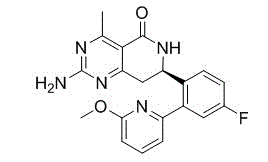| In Vivo: |
NVP-HSP990 (2.5 to 5 mg/kg twice weekly, or 5 to 15 mg/kg weekly, p.o.) causes dose proportional antitumor efficacy, without obvious loss or overt signs of toxicity in a GTL-16 tumor bearing mice. NVP-HSP990 (5 or 10 mg/kg weekly, p.o.) also results in significant inhibition of tumor growth in BT-474 breast cancer model. NVP-HSP990 (5 mg/kg twice weekly or 15 mg/kg weekly, p.o.) inhibits the growth of tumor in the MV4;11 xenograft model. Furthermore, NVP-HSP990 (0.5 mg/kg every day, 14, 5 mg/kg twice weekly, or 15 mg/kg weekly, p.o.) displays antitumor efficacy in H1975 and A549 tumor models[1]. NVP-HSP990 (5, 15 mg/kg, p.o.) shows prolonged suppression of c-Met levels with 30% and 50% reduction and exhibits antitumor activities in GTL-16 tumor xenograft[2]. |
| In Vitro: |
NVP-HSP990 is a potent and selective Hsp90 inhibitor, with IC50 values of 0.6, 0.8, and 8.5 nM for Hsp90α, Hsp90β, and Grp94, respectively. NVP-HSP990 (10 μM) shows no affect the ATPase activity of topoisomerase II, a GHKL (Gyrase, Hsp90, Histidine Kinase, MutL) family ATPase, closely related to Hsp90. NVP-HSP990 also exerts efficient effects on c-Met, Hsp70, p-ERK and p-AKT in CTL-16 cells, with EC50s of 37 ± 4, 20 ± 2, 11 ± 1, and 6 ± 1 nM, respectively. NVP-HSP990 suppresses the proliferation of BT474, A549, H1975 and MV4;11 cells, with GI50s of 7 ± 2, 28 ± 5, 35 ± 4, and 4 ± 1 nM, respectively[1]. NVP-HSP990 inhibits cellular proliferation of GTL-16, with an EC50 of 14 nM[2]. NVP-HSP990 (5-500 nM) inhibits the multiple myeloma cell lines, with IC50s of 27-49 nM after treatment for 72 h. NVP-HSP990 induces apoptosis in multiple myeloma cell lines (0-100 nM), leads to cell cycle arrest in the G2/M phase (25-200 nM), and induces apoptosis via caspase-8 followed by caspase-3 activation (100 nM). NVP-HSP990 increases HSP70 expression and interacts with Akt and ERK signaling. Moreover, NVP-HSP990 (100 nM) in combination with melphalan, causes synergistic effects on growth inhibition in multiple myeloma cells and increases cleavage of caspase-3, caspase-8, and caspase-9 and activates caspase-2[3]. |

 DC Chemicals' products qualify for U.S. tariff exemptions. We guarantee no price increases due to customs duties and maintain stable supply, continuing to deliver reliable research solutions to our American clients.
DC Chemicals' products qualify for U.S. tariff exemptions. We guarantee no price increases due to customs duties and maintain stable supply, continuing to deliver reliable research solutions to our American clients.





















